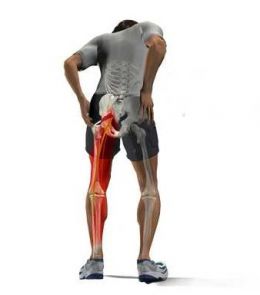
Piriformis syndrome is an irritation of the piriformis muscle. Piriformis muscle connects your hip to your pelvis in a strap-like fashion across the buttock and is responsible for rotating your hip outward. If the side of your glutes is achy and possibly sending pain down the back of your thigh, you may be suffering from Piriformis Syndrome.
Buttock pain from piriformis syndrome may or may not bother you while running, but can make sitting afterward very uncomfortable. Often, walking uphill or climbing stairs will aggravate your buttock pain as well. In some cases, the pain will refer down the back of your leg because of the proximity of your piriformis muscle to the sciatic nerve. In this case, your problem is in your buttock, not your back.
Should I Stop Running If I Have Pain in Buttocks?
Most runners suffering from piriformis syndrome can safely keep running. However, making modifications to your training and cross-training programs can help improve your odds of a successful race day.
Seek Help to Get Rid Of Pain
If you are a runner suffering from buttock pain, don’t ignore it! Often runners have been suffering from pain for months before seeking help. It’s not until their training program intensity peaks that runners seek out help. Unfortunately, treating the pain becomes harder the longer it’s been around. Early action makes piriformis pain easier to resolve and improves your odds of achieving your personal best on race day.
Physical Therapy for Piriformis Syndrome
Physical therapy for piriformis syndrome helps to relieve pain and restore normal movement and range of motion in the affected area. Physical therapist designs a customized treatment program tailored to the patient’s specific condition. Most patients regain full function following 4-6 weeks of physical therapy.